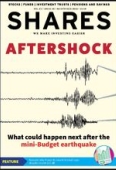Archived article
Please note that tax, investment, pension and ISA rules can change and the information and any views contained in this article may now be inaccurate.
Why dollar strength and foreign exchange volatility is bad for stock markets
After a relatively calm period foreign exchange markets have become a source of stock market uncertainty. Sharp moves in exchange rates are not conducive to international trade which has already suffered from the effects of the pandemic.
The recent 10% fall in sterling against the US dollar may help UK exporters (goods are cheaper for foreign buyers) but the other side of the coin is that imports become more expensive, contributing to inflation and reducing margins.
This puts pressure on the Bank of England to tighten policy when the government’s loose fiscal policy is pulling in the other direction. The same tussle is happening in the US and the EU. The divergence is contributing to currency volatility.
The clear winner has been the US dollar. The world’s reserve currency has been on fire, gaining around 20% against a broad basket of currencies.
Historically a strong dollar has been a harbinger of bad times to come. In 2008 the dollar gained 22% against that same basket of currencies amid the financial crisis and in 2020 on the eve of the pandemic it advanced 7%.
As a reserve currency the dollar is seen as a safe haven and investors tend to flock to it during times of market stress or fears of a downturn.
Morgan Stanley says every 1% increase in the value of the dollar reduces S&P 500 earnings by around 0.5%. It goes on to say the recent move in the greenback creates an ‘untenable situation for risk assets’ that has historically ended in a crisis.
The Japanese yen has fallen by more than a quarter this year to 24-year lows as the central bank sticks to an accommodative policy in contrast to most other banks.
Most commodities are priced in US dollars and its strength has made it more difficult for emerging economies which rely on importing food and other essentials. Several emerging economies also have foreign debts priced in dollars.
The Brazilian real and Mexican peso have held-up well with both currencies gaining against the US dollar, reflecting economic resilience and sought-after exports.
For investors with international portfolios, a weaker pound has increased the relative value of their foreign holdings.
Important information:
These articles are provided by Shares magazine which is published by AJ Bell Media, a part of AJ Bell. Shares is not written by AJ Bell.
Shares is provided for your general information and use and is not a personal recommendation to invest. It is not intended to be relied upon by you in making or not making any investment decisions. The investments referred to in these articles will not be suitable for all investors. If in doubt please seek appropriate independent financial advice.
Investors acting on the information in these articles do so at their own risk and AJ Bell Media and its staff do not accept liability for losses suffered by investors as a result of their investment decisions.
Issue contents
Feature
Great Ideas
- Ruffer delivers positive return in difficult times but sees more pain for investors
- Ideal time to invest in life sciences cheaply through this trust
- Essentra's transformation to a pure-play industrial supplier is now complete
- How Crestchic is powering up for a growth push and why now is a great time to buy
Investment Trusts
News
- Will Porsche shares surge like Ferrari or skid like Aston Martin?
- Resilient Greggs holds firm on outlook in good start for Roisin Currie
- FTSE 100 firms set for record cash return in 2022 but pressures are mounting
- Find out which stocks surged and slumped during a turbulent third quarter
- Why dollar strength and foreign exchange volatility is bad for stock markets

 magazine
magazine








